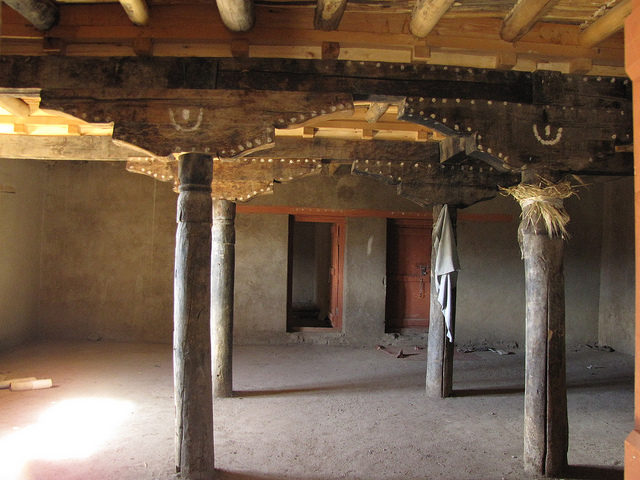Completed in the 17th century, this gigantic nine-story structure is located in the town of Leh in the Indian state of Jammu and Kashmir, and is one of the finest surviving examples of medieval Tibetan architecture. With a breathtaking view of the Himalayas, the palace today is a popular tourist attraction for visitors from around the world. Construction of the palace was begun in 1553 by Tsewang Namgyal, the founder of the Namgyal dynasty and was completed by Sengge Namgyal, his nephew, in the 17th century.
Built of sand, wood, and stone, the Leh Palace is based on the Potala Palace in Lhasa (the home of the Dalai Lama until 1959). After it was completed, the eighth and ninth floors were used by the kings for residential purposes. On the other floors, there were storage rooms and stables where the horses of the army were kept.
It was abandoned in the 19th century when the royal family had to leave the area because of the attack of the Dogra forces. Severely damaged by the wars, the palace today is in a slightly ruined condition.

The carved entrances are decorated with various wooden figures and ornaments. The surviving murals on the ruined walls of the palace show a small part of the beauty of the interior from the 17th century. The Archaeological Survey of India is currently working to restore the palace and there are few preserved rooms and corridors today which serve as exhibition halls.

Inside these halls, there are paintings which are almost 500 years old and because they were made from gems and powdered stones, they are still brightly-colored and fresh. Another fascinating aspect of the palace is the extensive collection of royal crowns, jewelry, and ceremonial dresses.

On the fourth floor is the Dukhar Temple covered with many images of the Star Goddess Tara. There is also a monastery inside in which a beautiful Buddha statue is seated. Lying just above the palace is the Victory tower which was built in the memory of the Ladakhi soldiers who died in the war in Balti Kashmiri. It offers the best panoramic view of the Himalayas and the city, and it is a famous landmark in the state.

On the base of the building, there are several stupas, including the most famous Namgyal stupa built in memory of Buddha, the Chandazik Stupa filled with colorful murals, and the old Chamba Lhakhang stupa built in the 15th century. Although much of the building remains abandoned, the Archaeological Survey of India has plans to restore the entire building.

A small portion of the palace has been restored, and at the moment they are working on the fourth floor which houses the Dukhar temple. Besides the palace, the old town of Leh is also in poor condition and requires urgent repairs. Because of that reason the town, together with the palace, is on the World Monuments Watch. The palace is the finest historical building constructed in Ladakh, and since 2003, the local government in conjunction with the Tibet Heritage Fund has been working to help ASI restore it.

Unfortunately, seven years ago, there was a bad storm and flash floods severely damaged the region. Until today, the people of the old town together with this organizations are still trying to repair the damage of the building and the surrounding area. Leh Palace remains an architectural icon and the most popular tourist attraction in Ladakh because of the mesmerizing view of the mountains. Many visitors come to see it every year and enjoy the beautiful surroundings.
